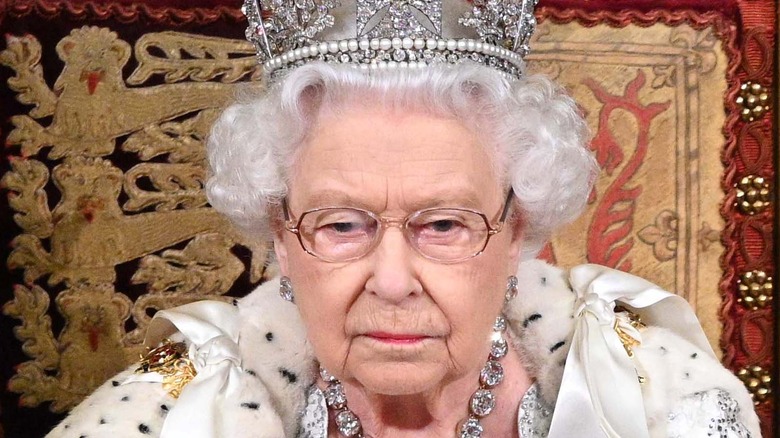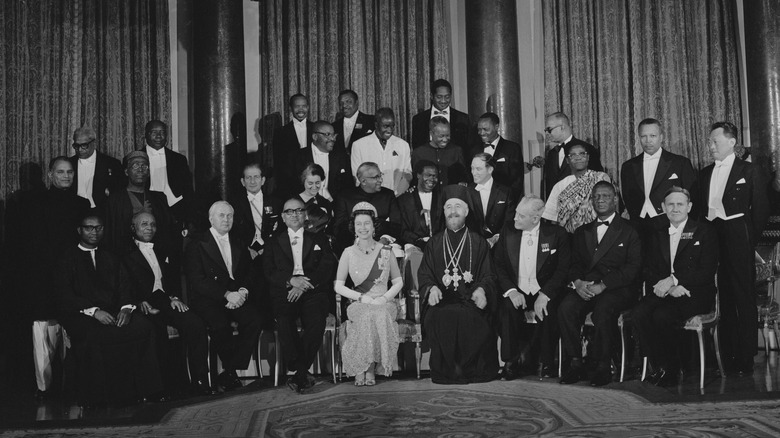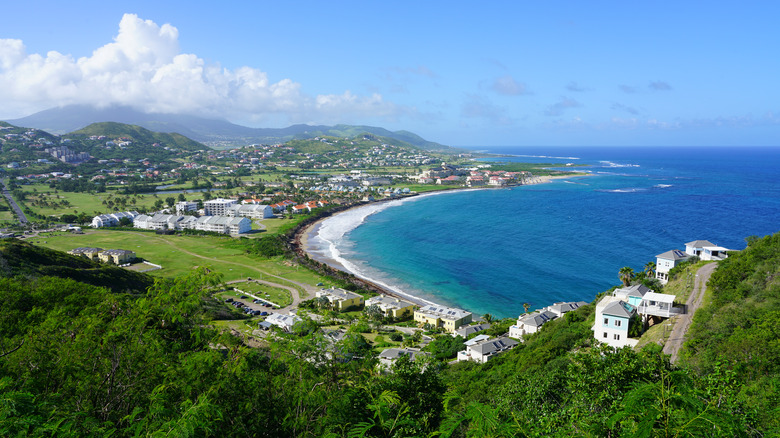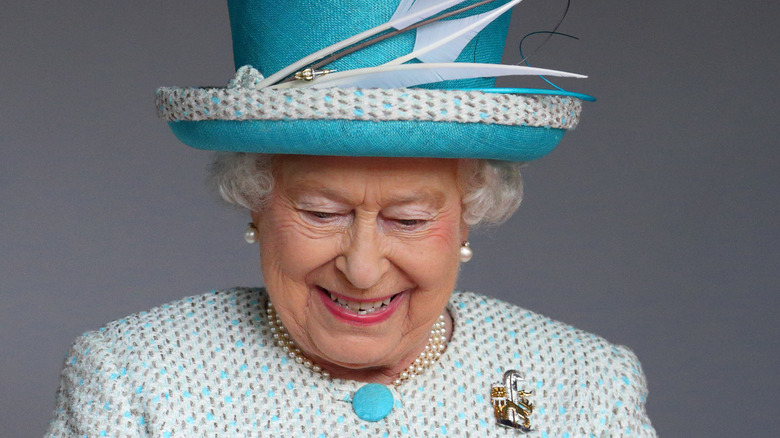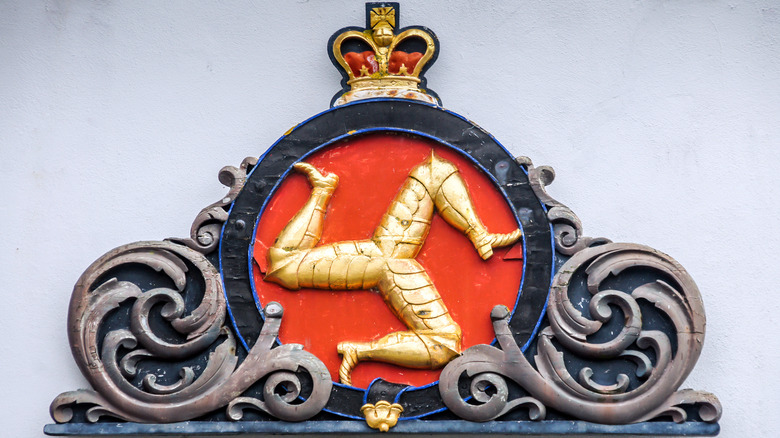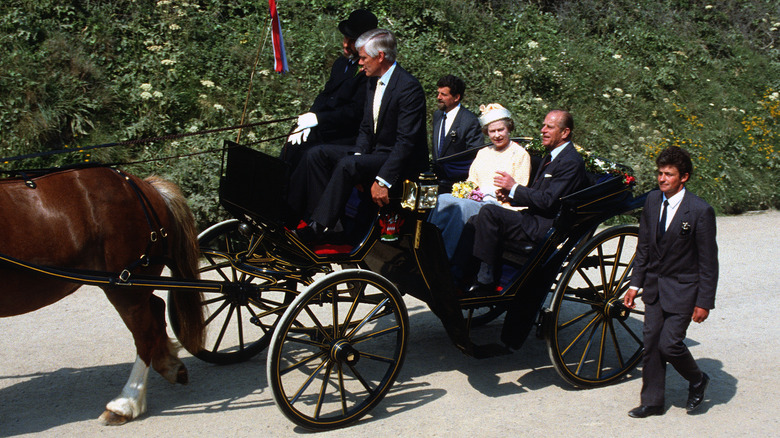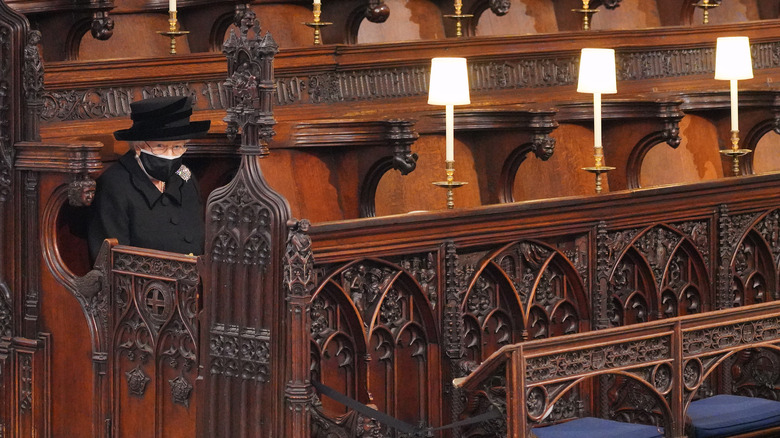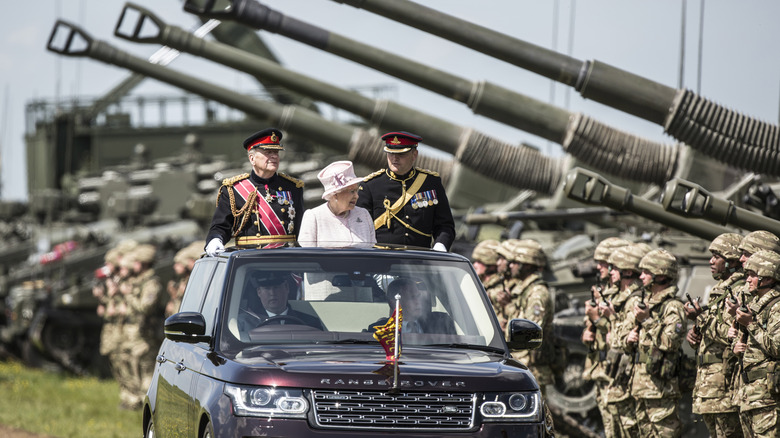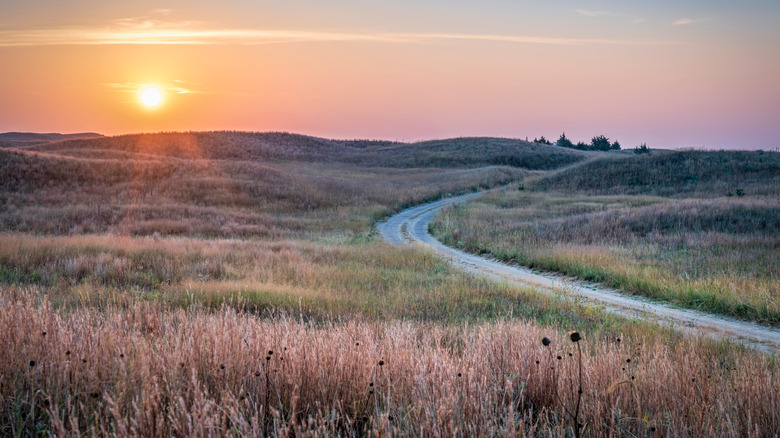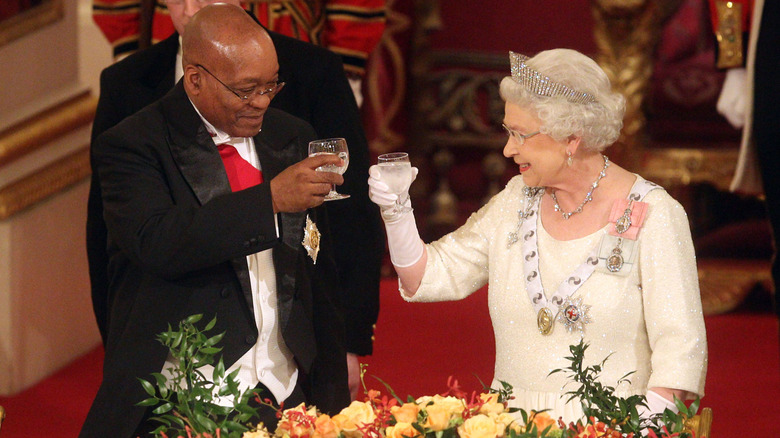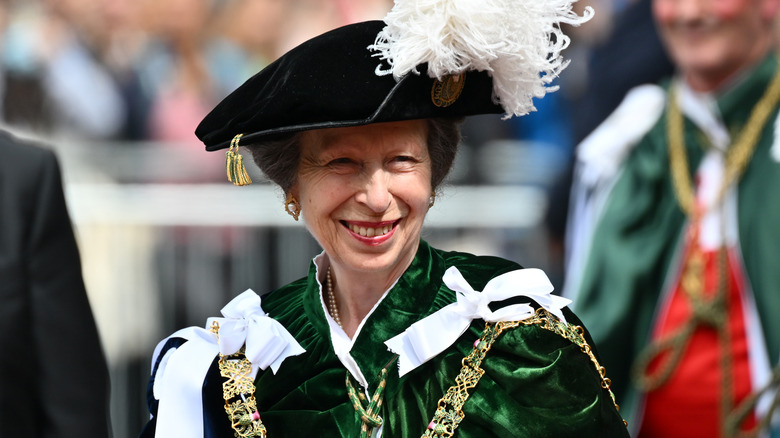Surprising Titles Held By Queen Elizabeth
Throughout history, monarchies have accumulated titles. Whether through inheritance, marriage, conquest, or a combination of all three, kings and queens bring more realms under their writ and lengthen the string of letters after their name accordingly. The full title of the Russian tsars named 52 countries, territories, or regions governed or claimed by them (per Robert K. Massie's "Nicholas and Alexandra"), and the official address of the Ottoman sultans was even longer (per TheOttomans.org). Against that, Queen Elizabeth II's title seems modest: By the Grace of God, of the United Kingdom of Great Britain and Northern Ireland, and of Her Other Realms and Territories Queen, Head of the Commonwealth, Defender of the Faith (per Burke's Peerage).
That's only the modern usage, of course. The U.K. has claimed and controlled significantly more territory than that in the past. It was only in 1948 that "Emperor/Empress of India" was taken off the list. Nor has the dissolution of the British Empire necessarily cost the queen that many honors. She still reigns as sovereign over 14 Commonwealth realms in addition to the U.K. (per the official website of the royal family, Royal.uk) and retains various forms of address through honor or custom. Here are the most surprising titles held by Queen Elizabeth II.
The devolved monarchies
When Elizabeth II first became queen in 1952, the British Empire had already begun to dissolve. The peak of decolonization came in the 1960s, according to the BBC, but India and Pakistan had already become independent, and the title of emperor went with them. The queen at this time was styled "By the Grace of God, of Great Britain, Ireland and the British Dominions beyond the Seas Queen, Defender of the Faith" (per Burke's Peerage).
As poetic as "Dominions beyond the Seas" may be, it no longer suited the reality of Britain's evolving relationship with its former colonies. The claims and wording of the royal style and title had been in dispute since 1927, according to Anne Twomey's "The Chameleon Crown," and the debate was renewed by India's independence and Ireland's withdrawal from the Commonwealth. The remaining Commonwealth nations and realms had different ideas on how to style the queen and whether it should be consistent across all countries.
The Prime Ministers' Conference of 1952 resolved the matter with an agreement that each Commonwealth nation would craft a royal style and titles that suited its own needs, with "of Her other Realms and Territories" a connecting element for them all. Some, like Canada and Australia, retained a reference to the U.K., while others only referred to themselves. How many countries name Elizabeth queen, and how they word her title, has changed with time, but those changes are now in the hands of the realms themselves.
Of Saint Christopher and Nevis, Queen
Per the agreement reached at the Prime Ministers' Conference of 1952 (via Anne Twomey's "The Chameleon Crown"), the Commonwealth realms grant Elizabeth II a style and titles fitting their needs. Among those realms is the two-island nation of Saint Kitts and Nevis, the smallest country in the Western Hemisphere by size and population according to the UN. Here, the queen's title is "by the Grace of God of Saint Christopher and Nevis, Queen, Head of the Commonwealth," according to the Saint Kitts Nevis Information Service. Why the discrepancy between the title and the name of the country?
The larger of the two islands, Saint Kitts, is officially the Saint Christopher Island. It was named so by Christopher Columbus in 1493, according to Britannica, on his second voyage. It became known as Saint Kitts after a colony was established there by Sir Thomas Warner, the first of the English colonies in the West Indies to succeed. Saint Kitts became a self-governing union with Nevis and Anguilla in 1967. Full independence came in 1983, with Anguilla having left the federation three years earlier.
Though better known as Saint Kitts, Saint Christopher remains the formal name of the island and the nation, hence its use in the queen's title. As with all the Commonwealth realms outside the U.K., the queen is represented by an appointed governor-general, who keeps her regularly informed on the state of the nation according to Royal.uk.
The Duke of Lancaster
The Duchy of Lancaster, according to its official website, first came into royal possession when Henry III bundled various confiscated lands of the nobility, granted them to his son and heir, and named him Earl of Lancaster in 1266. In 1351, Edward III granted it to Henry Grosmont, created him duke, and raised Lancaster to a County Palatine. This meant it functioned as a devolved power within the kingdom, its nobles enjoying quasi-royal authority. Lancaster re-entered royal hands through marriage and was eventually designated a private estate of the monarch by Henry IV, to be passed from one reigning sovereign to another.
The duchy provides the sovereign with a source of income, though since 1702, they cannot collect capital from the estate. A council manages its day-to-day affairs, though its officers are directly responsible to the sovereign. As a private holding of the monarch, it is managed separately from the Crown Estate, which generates income for the Treasury (per the Crown Estate's website).
Since Henry IV's coronation in 1399, the sovereign has also been the duke, regardless of sex. According to the duchy's FAQ page, Queen Victoria felt that the holder of a dukedom should always be called a duke, with "duchess" a courtesy title for their consort. This has become a matter of tradition and preference rather than an official policy, but within the County Palatine, Elizabeth II is still often toasted as "the Queen, Duke of Lancaster" (per the duchy's website).
Lord of Man
Let the fears of antimonarchists be quelled: "Lord of Man" is not a claim to sovereignty over all mankind. It's Elizabeth II's title in regards to the Isle of Man, situated in the Irish Sea. Per Britannica, the island was a popular home of Irish missionaries before invasions by Norsemen beginning in the 800s. It became a dependency of Norway until it was sold to Scotland and then came under English rule. The English lords who governed the island were initially styled "kings of Mann," but when the Crown granted it to Sir John Stanley, he and his heirs refused a royal title and referred to themselves as "lord of Mann."
After becoming a hub of smuggling in the late 18th century, Parliament bought control of the Isle of Man. Today, it exists as a Crown dependency – a self-governing territory under the possession of the Crown, with the British Home Office supervising its internal affairs and claiming responsibility for foreign policy and defense (per Royal.uk). While not an identical arrangement to the Commonwealth realms, the Isle of Man still has an appointed representative for the sovereign, a lieutenant governor, who serves for five-year terms, according to the website of the Tynwald (parliament).
The reigning monarch has been Lord Proprietor of the Island since Parliament's purchase of sovereignty in 1765. The shorter, more traditional form is combined with the royal title in formal addresses to Elizabeth: she is called "the Queen, Lord of Man."
Duke of Normandy
In 2019, the BBC reported that plans by Westminster to change laws in the Crown dependencies had stirred fears of a constitutional crisis. While the British government retains responsibility for foreign and defense matters on behalf of the dependencies, they have long had autonomy in domestic affairs. Among the Crown dependencies are the Channel Islands, Jersey, and Guernsey, which boast a unique relationship – and title – with the British Crown.
The Channel Islands were once part of the Duchy of Normandy, created by the Treaty of St. Clair-sur-Epte between Charles III of France and Rollo the Viking (per Britannica). When William, Duke of Normandy, won the Battle of Hastings and became William the Conqueror, the duchy and England became linked. Inheritance gave the two to different children of William, but Henry I took the duchy from his brother Robert in 1106 (per Royal.uk) and added "Duke of Normandy" to the English Crown's list of titles.
Per the International Court of Justice, Normandy came back under French control in 1204, but the Channel Islands remained in English hands. While English and later British monarchs continued to be called Duke of Normandy by convention, the terms of the 1259 Treaty of Paris (per "The Channel Islands") specify that the reigning sovereign governs as king or queen, not as a duke. Still, within Jersey and Guernsey, Elizabeth II will often be referred to as Duke of Normandy or "the Queen, our Duke."
Defender of the Faith
The phrase "Defender of the Faith” at the end of Elizabeth II's title can seem odd in today's Britain. A 2020 YouGov survey found more than half of Britons were irreligious. But the monarch's title of Defender of the Faith has a long history. It was first granted to Henry VIII in 1521 by Pope Leo X (per Britannica). Henry's suitability for the claim came into doubt when he broke ties with Rome over another pope's refusal to annul his marriage to Catherine of Aragon (per History), but Parliament reinstated the title in 1544.
Per Royal.uk, the reigning sovereign of the U.K. is also Supreme Governor of the Church of England. They have the power to appoint its leaders, though this is done on the advice of the prime minister. The church is practically governed by an elected synod, empowered to legislate for the church but which must obtain parliamentary and royal approval. The monarch's role as supreme governor does not extend outside of England; the Church of Scotland, being Presbyterian, recognizes no such authority.
Despite the increasing irreligiosity of her people, the queen has remained a devout Christian her entire life. She's even become more outspoken about her faith, according to Theos, reflecting on its value in her life during her annual Christmas messages. And while not personally responsible for the day-to-day governance of the Church of England, she has, by example, influenced a rapprochement between Anglicanism and other faiths.
Commander-in-chief
Among the arguments put forth by monarchists for retaining a sovereign is that they serve as a check against other state actors. As a letter to the Telegraph (via the Constitutional Monarchy Association) put it: "While the Queen occupies the highest office of state, no one can take over the government ... while she is ultimately in command of the Armed forces, no would-be dictator can take over the Army. The Queen's only power, in short, is to deny power to anyone else."
Elizabeth II's command of the army isn't quite that absolute. As head of state, the monarch is the commander-in-chief of the U.K.'s military. Per Insider, the oath sworn by the soldiery is to the sovereign, not to the prime minister, Parliament, or a constitution. The queen also retains the power to declare war, though she has never done so. It, like all her powers, is subject to the advice and approval of the government. "Ultimate authority on the Army's deployment and use rests with Parliament and 'the people,'" says the National Army Museum. But in the event of an attempted coup, such as happened in Spain in 1981 (per The Guardian), the queen's position could theoretically deny it any legitimacy.
It isn't only in the U.K. that the queen retains command of the armed forces. The Government of Canada still acknowledges her as head of the military. As with all her functions in Canada, the queen is represented as commander-in-chief by a governor-general.
Admiral in the Great Navy of the State of Nebraska
Who says that titles must be solemn and profound? The state of Nebraska has been having fun with its highest civic honor since 1930. Even though it is the only state in the union that is triply landlocked, Lieutenant Governor TW. Metcalfe began appointing his friends "Admirals in the Great Navy of the State of Nebraska" (per the Military Times). Comparable to a Kentucky Colonel but much more playful, the admiralship is intended for those deemed by the governor to have made a significant contribution to the state. Submitting candidates is still done by post, per the state government's website, which specifies that nominees must reside within Nebraska.
Those are the current rules. A look through the list of famous honorees maintained by the Nebraska Admirals Association reveals that the state hasn't always kept command of its illustrious navy to its own citizens. Non-Nebraskans granted an admiralty include Franklin D. Roosevelt, Ronald Reagan, Bob Hope, and Bill Murray. Some admirals haven't even been American – such as Queen Elizabeth II.
Admiralty in a state with no need for maritime power may not have brought the queen any jewels, medals, or sacred oaths. But she would have received a certificate acknowledging the "officers, seamen, tadpoles, and goldfish" subject to her command, while also cautioning her that she may be subject to orders herself to maintain "the rules and discipline of the Great Navy of the State of Nebraska."
Companion in Gold of the Order of the Companions of O. R. Tambo
Heads of state will sometimes trade honors with one another. Before World War I, when many of the royal families of Europe were closely related, they often awarded one another; Queen Victoria awarded her grandson Kaiser Wilhelm II the Order of the Garter when he was only a teenager (per History.co.uk). The British royal family is itself an offshoot of a German house, which led to an awkward situation during World War I. Under public pressure, George V changed the family name to Windsor and dispensed with all German titles (per the Independent).
The practice of royalty receiving honors from their fellows hasn't entirely vanished today. Elizabeth II is a Knight of the Order of the Elephant in Denmark (per Burke's Peerage), while Queen Margrethe II of Denmark is a Stranger Lady of the Order of the Garter (via Royal Central). But such exchanges aren't limited to monarchs. In 2010, Jacob Zuma, president of South Africa, paid a state visit to the U.K., and he and the queen presented one another with honors. According to the South African government website, the queen was made a Companion in Gold of the Order of the Companions of O. R. Tambo, an order open to foreign dignitaries promoting friendship, cooperation, and peace with South Africa. Zuma received the Order of Bath, typically given to members of the civil service but often awarded by the queen to foreign heads of state.
The title she never had
Elizabeth II has never lacked for styles and titles. Even at birth, she had one: Her Royal Highness Princess Elizabeth of York, according to the Royal Collection Trust. But there is one title, fairly well-known in the U.K., that she has never held. Not once in her life has the queen been known as Princess Royal, not even when she was the heir to George VI. That's because "Princess Royal" isn't passed on by heredity or automatically granted based on birth order; it's bestowed at discretion.
Per Royal.gov.uk, "Princess Royal" is an honorary title given by custom to the reigning sovereign's eldest daughter, dating back to Princess Mary in 1642. After falling into disuse, it was revived by George II and his successors. While it's meant for the eldest daughter of the monarch, it is up to the monarch to bestow it, and they may wait years before they choose to do so.
Princess Royals hold the title for life, according to Town and Country Magazine, and there cannot be more than one Princess Royal at a time. That's why the queen was never Princess Royal. Her aunt, another Princess Mary, was awarded the title in 1932 and held it until her death in 1965. In that span of time, Elizabeth became heir to the throne and then queen, and so never had an opportunity to become Princess Royal herself, although she did bestow the title on her daughter, Princess Anne.
